The Dao traditional food has become a diverse, rich, and sophisticated cultural treasure, shining through its careful selection of ingredients, preparation methods, and enjoyment. The robust mountainous flavors of this region bring forth exceptional culinary experiences.
Through this article, Loka Ha Giang is delighted to introduce to you the most unique and distinctive dishes of the Dao ethnic group. These are flavors that you cannot forget in your journey to explore the unique culinary culture of this land.
Sour Pork
Salted pork, a Dao traditional food, is an alluring symbol in the mountainous cuisine. What makes it special is that each ethnic group has its own unique preparation method, resulting in diverse flavors. However, true to the reputation of the “Dao Tiền people who love salted pork,” their distinctive way of making it leaves an unforgettable impression after just one taste.
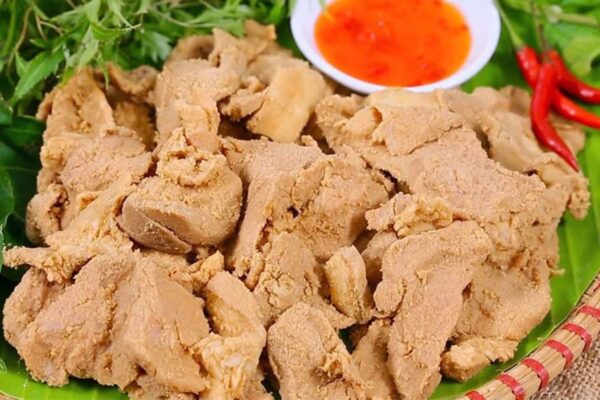
The process of preparing salted pork is not overly complex, but it requires dedication and time to achieve excellent results. The necessary ingredients include pork belly or fat with skin, fine salt, and cooled rice. The pork is cut into pieces of about 0.5 kg each, and a sharp knife is used to lightly score the surface to ensure the skin is not cut. Next, the meat is thoroughly marinated with a generous amount of salt, then mixed evenly with the cooled rice to allow the meat to absorb the flavor.
The next step is crucial; the salted pork is tightly packed into a container called “chum” and firmly pressed to ensure even absorption of the salt. The top of the chum is covered with clean straw, and then wrapped tightly with dong leaves. The tight sealing of the chum prevents air from entering, and it is placed upside down in a container filled with ashes.
The ashes will help the meat ferment over time, and during this process, the fat and juices from the meat will seep into the ashes, creating a unique flavor for the dish. When the salted pork reaches perfection in terms of color, saltiness, tanginess, and the aroma of betel leaves, it becomes an unforgettable taste. This salted pork dish with its rich, savory, and enticing flavor leaves a lasting impression on those who savor it.
Taro Sticky Rice
Taro Sticky Rice, a Dao traditional food, holds a familiar and sacred place in their daily life as well as in welcoming guests and celebrating festivals. It is an ancestral creation to express gratitude towards nature for providing them with sustenance and sustainable living.
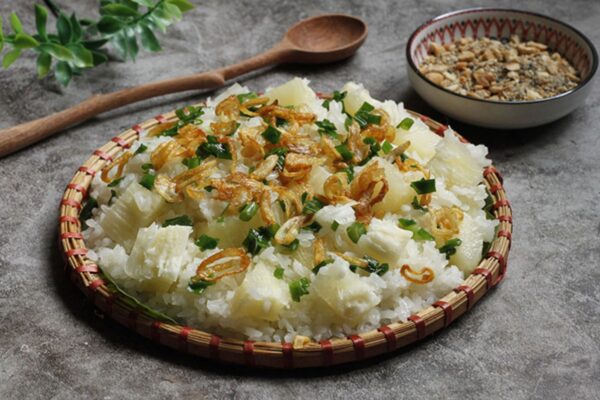
The process of preparing taro sticky rice is not complex, but it holds a special allure compared to other types of sticky rice. Taro has long been a staple in the Dao people’s meals, with its young shoots used for vegetables and pickles, and its roots boiled, sliced, and dried for storage from one season to another. Taro sticky rice can be enjoyed in everyday meals, served to guests, or on festive occasions.
When the taro sticky rice is cooked, the soft and tender white glutinous grains are poured onto the plate, exuding a delightful fragrance. The Dao people believe that the white color symbolizes the purity of nature and the morning dew on the hills. They deeply appreciate the essence and delicacy of each white rice ball wrapped in banana leaves, dong leaves, or other forest leaves.
Each family has its own way of wrapping taro sticky rice, such as some families neatly shaping it into cylindrical pieces resembling ancient pestles (also known as “co chay” taro sticky rice), and when eating, they cut it into small rounds. This delectable taro sticky rice can be paired with sesame salt, chili salt, or enjoyed with grilled fish, creating an exquisite and flavorful dish.
Smoked Hanging Pork
Son La Kitchen Hang Pork, a Dao traditional food from the Northwestern region of Vietnam, stands out as a unique culinary artistry. Unlike many other dishes, Hang Pork is not only a method of preserving food for longer periods but also a special delicacy often savored on rainy days or when there’s no market. What makes this dish truly exceptional is the blend of spices used for marinating, creating the distinctive and refined taste of the Northwestern culinary heritage.
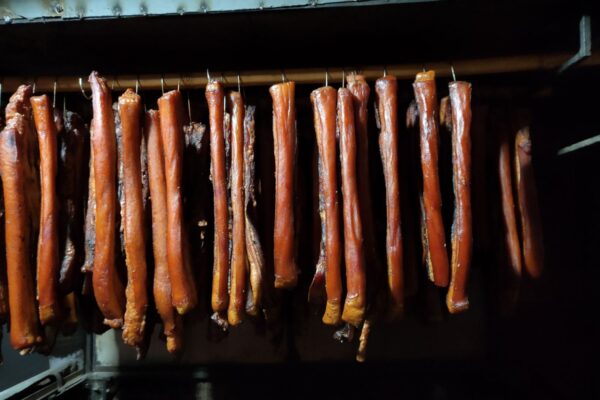
This traditional food is also a favorite among the H’mong, Tay, and Thai ethnic groups, and Hang Pork carries the characteristic flavors and culture of the region. Integral to traditional festivals and celebrations, Hang Pork has left a lasting mark on the cuisine and lives of the local ethnic communities.
The intricate aroma of Sơn La pepper and wild almond, combined with the spiciness of ginger, chili, and white wine, all infused during the process of smoking the pork on the kitchen hang, results in a truly unique and incomparable flavor. Hang Pork from Sơn La is indeed a remarkable dish, imbued with the distinctive charm and allure of the Northwestern Vietnam region.
Once you’ve experienced the unique and bold flavors of this Northwestern delicacy, it becomes hard to forget. The distinctive scents of Sơn La pepper and wild almond, combined with the captivating smoky aroma during the smoking process, create the unique and alluring essence of Sơn La Kitchen Hang Pork.
Five-color Sticky Rice
Xoi ngu sac, a Dao traditional food, carries profound cultural and traditional significance for the Dao people. Its distinct characteristic lies in the combination of five colors, each representing the five elements that constitute the earth, the sky, and all living things. Additionally, the vibrant colors of xoi ngu sac also symbolize prayers for a peaceful, fortunate, and bountiful life.
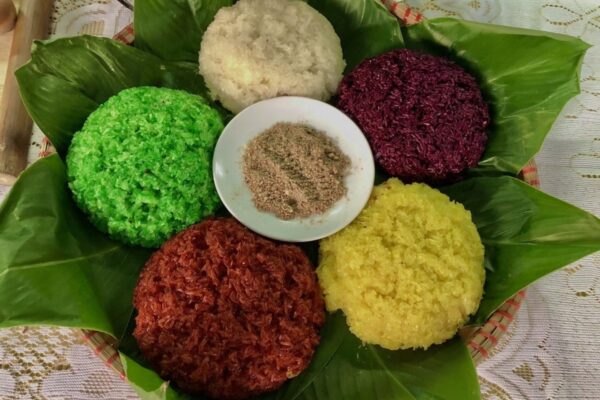
To prepare xoi ngu sac, the main ingredients are glutinous rice and various forest leaves used to dye the rice grains. The authentic Thuong Yen Cong xoi ngu sac requires using glutinous rice harvested from the fertile fields of Thon Tap Doan, Khe Su. The grains of this glutinous rice are slender, slightly pale white, unlike the pure white grains of ordinary glutinous rice. During the processing, special care is taken to sift out broken or uneven grains.
A distinctive feature of xoi ngu sac in Thuong Yen Cong is its black color, derived from the leaves of thau thau – a forest plant commonly found in the region. The specific type of thau thau leaves, collected around the lunar month of March, yields the most lustrous black color for the xoi. The process of preparing thau thau leaves is more intricate, involving crushing the leaves, soaking them in water overnight, and then boiling the extract until it forms sediment. This black-colored water is used to soak the rice, giving it the characteristic black hue.
Xoi ngu sac often appears on ancestral worship altars or served to esteemed guests. When accompanied by dishes like grilled meat or braised pork, xoi ngu sac creates a harmonious overall experience of flavors and colors, making it irresistible to any diner.
Bamboo-tube Rice (Com Lam)
Com lam – Dao traditional food,, also known as “dong dua” in the language of the Dao people, is a special traditional baked rice cake that carries the sacred flavor of this ethnic group. The best season to make com lam is in April when the bamboo shoots sprout young, tender, and with a thin white paper-like layer inside the tube. The process of making com lam starts with thoroughly washing the bamboo tubes, then filling them with glutinous rice and water before sealing them tightly with banana leaves from the forest to enhance the aroma.
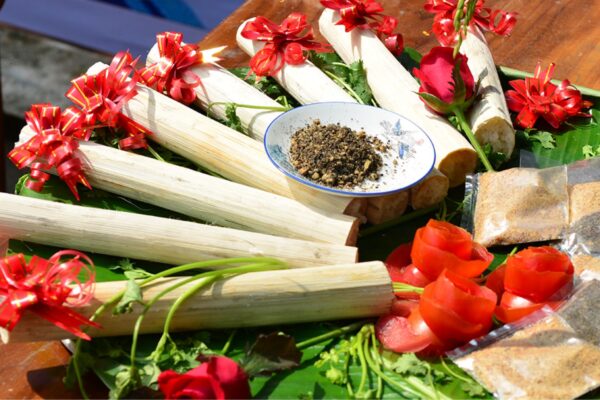
The most challenging and time-consuming step is the baking process, which takes up to 2 hours. It requires a large fire to ensure even cooking. Dao women have to sit by the fire for a long time, demanding great patience. When the rice inside the tubes starts to burn and water seeps out, they must tilt the tubes backward to ensure even cooking, and then roast the bottom of the tubes. Once the com lam is dry and emits its characteristic aroma, the fire is reduced to keep the heat steady. After cooking, the com lam is left to cool for 10 to 15 minutes, and experienced cooks believe that it tastes best when it’s cooled.
After cooling, the outer layers of bamboo are removed, leaving only a thin, pure white, and delicate rice cake, easy to peel before eating. The com lam must have a chewy texture and a delightful fragrance. When peeling off the bamboo layers, the com lam tubes reveal the rice cake with its paper-like covering.
Com lam can be preserved for up to two days without losing its freshness or becoming hard, making it a popular food choice for travelers and tourists. In the past, com lam was commonly eaten with sesame salt, but nowadays, the Dao people often enjoy it with shredded meat, grilled meat, and other dishes.
Below is a list of Dao traditional foods that we want to share with you. Each dish holds unique flavors, stories, and profound cultural values of the Dao people.

My name is Giap Van Hai, I am a travel enthusiast and always want to share the beauty of Ha Giang with everyone. With a deep love for the mountains and the typical culture of Ha Giang people, I decided to establish Loka Ha Giang – a website specializing in Ha Giang tourism services. We provide travel services such as Ha Giang Loop, Ha Giang Trekking, Ha Giang Easyrider
